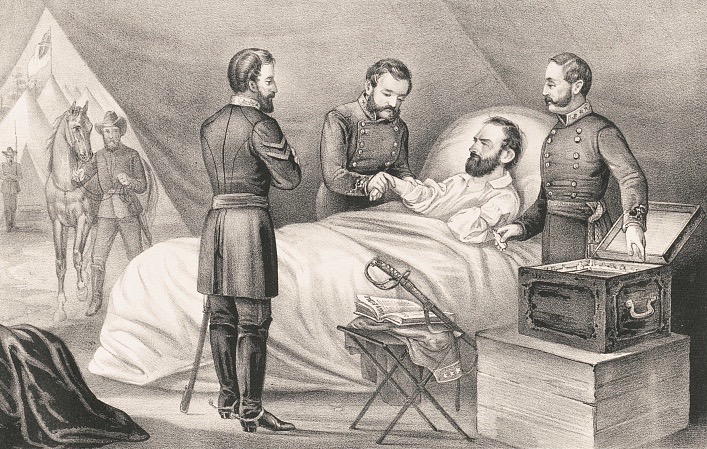In the darkness on May 2, 1863, having completed his famous and successful assault on the Union right flank near Chancellorsville, Confederate Lieutenant General Thomas J. “Stonewall” Jackson, accompanied by members of his staff, rode beyond his lines to personally reconnoiter the Union position. Mistaken identity, coupled with the confusion and nervousness that inevitably attend nighttime operations, ended with a volley of Confederate musketry slicing through the woods around him.
Three balls found their mark in Jackson, two of which effectively shattered his left arm. He was taken to a field hospital at Wilderness Tavern, five miles to the rear, where doctors amputated his damaged limb the following morning. Eventually, Jackson was transported more than 26 miles to Guinea Station, where it was hoped he would board a train for Richmond. He never made it. Pneumonia set in, and on May 10, 1863, the general died in a small plantation outbuilding along the side of the tracks. His remains were taken to Lexington, Va., where he is buried.
“He has lost his left arm; but I have lost my right arm.”
General Robert E. Lee
Today four monuments or markers commemorate Jackson’s fate. Two, a simple quartz boulder and a more elaborate granite column, mark the area on the Chancellorsville battlefield where Confederate musket fire struck and wounded the general. Another stands beside the small building where he died eight days later. The fourth, however, is possibly the most unusual, if not the oddest, memorial erected on any battlefield from the war.
In a small family cemetery on the Ellwood plantation, located on the eastern edge of Orange County, Va., stands a simple granite marker. It is the only marker in the cemetery, but it does not memorialize any of the family burials there. Carved into the face of the stone is “Arm of Stonewall Jackson, May 3, 1863.”
Following Jackson’s amputation, the Reverend Beverley Tucker Lacy, the unofficial chaplain of Jackson’s Second Corps, paid a visit to the hospital, where he discovered his chief’s amputated limb. Lacy wrapped it in a blanket and rode the one mile to his brother’s home, Ellwood. There, he buried the severed limb in the family cemetery. In later years another member of Jackson’s staff, Lieutenant James Power Smith, settled in Fredericksburg and married a member of the Lacy family. In 1903 Smith placed 10 granite monuments on the local battlefields to mark important locations. One of those markers is the one that now stands in Ellwood’s cemetery.
In addition to Stonewall’s shattered limb, two other burials took place in the Lacy graveyard during the Battle of Chancellorsville. Captain James Keith Boswell, the energetic and competent engineer officer assigned to Jackson’s staff, was also buried there, killed by the same volley that wounded his chief. Boswell’s remains were carried to Ellwood by Jedediah Hotchkiss, Jackson’s topographical engineer. Another officer laid to rest in that cemetery was Major Joshua Stover, who served in the 10th Virginia Infantry and fell in battle on May 3, 1863. After the war, the remains of Stover and Boswell were moved to the Fredericksburg Confederate Cemetery.
For some reason, Jackson’s arm was not reunited with the rest of his remains in Lexington. That is not to say, however, that the arm was never disturbed. Curiosity seekers are purported to have dug up Jackson’s arm at least twice since its initial interment. Just a year following the burial, the armies found themselves locked in battle on the Lacy property. On May 5, 1864, during the Battle of the Wilderness, Ellwood served as the headquarters for Union Maj. Gen. Gouverneur K. Warren.
A Maryland colonel, stationed on the Ellwood estate, made the following simple, yet intriguing, notation in his journal: “200 yard from here where S. Jackson dies. His arm dug up by some pioneers and re-buried.” In 1921 the U.S. Marine Corps conducted training maneuvers on farms adjacent to Ellwood. The legendary and eccentric commander of this force was General Smedley Butler. According to the then owner of Ellwood, Butler dismissed the notion of Jackson’s arm being buried there and ordered a squad of Marines to dig beneath the Smith marker to prove that nothing was there. Much to his astonishment, they unearthed the arm. Butler had it reburied and ordered a bronze plaque cemented to the top of the stone.
Since General Butler confirmed the presence of the arm, it has remained undisturbed. Each year thousands of people visit Ellwood. Most come specifically to see the cemetery and to pay their respects to the general whose severed limb now lies beneath Ellwood’s soil.
Ellwood’s interior is currently undergoing restoration. The building is staffed by members of the Friends of Wilderness Battlefield and is open on weekends from early May through late October. For hours of operation, check the park’s Web site at www.nps.gov/frsp.






